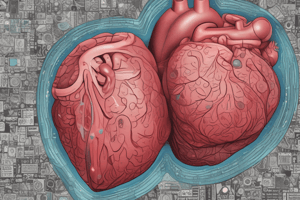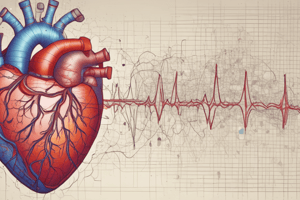Podcast
Questions and Answers
Which of the following is NOT a therapeutic use of beta-blockers?
Which of the following is NOT a therapeutic use of beta-blockers?
- Treatment of hypertension
- Cardiac arrhythmias
- Ischemic heart disease
- Hyperthyroidism (correct)
What is the primary reason for the ultrashort duration of action of esmolol?
What is the primary reason for the ultrashort duration of action of esmolol?
- It has a high volume of distribution.
- It is rapidly metabolized by cytochrome P450 enzymes.
- It undergoes extensive hydrolysis by plasma esterases. (correct)
- It is rapidly eliminated by the kidneys.
Which of the following statements about pindolol is correct?
Which of the following statements about pindolol is correct?
- It causes excessive bradycardia.
- It is a full agonist at beta-adrenergic receptors.
- It has no agonist activity at beta-adrenergic receptors.
- It is a partial agonist at beta-adrenergic receptors. (correct)
Which of the following statements about the use of beta-blockers in hypertrophic obstructive cardiomyopathy is correct?
Which of the following statements about the use of beta-blockers in hypertrophic obstructive cardiomyopathy is correct?
What is the mechanism by which propranolol manages symptoms of hyperthyroidism?
What is the mechanism by which propranolol manages symptoms of hyperthyroidism?
Which of the following statements accurately describes the classification of beta-receptor blockers?
Which of the following statements accurately describes the classification of beta-receptor blockers?
Which of the following statements about the use of esmolol in acute arrhythmias during surgery is correct?
Which of the following statements about the use of esmolol in acute arrhythmias during surgery is correct?
Which of the following statements accurately describes the cardiovascular effects of beta-blockers?
Which of the following statements accurately describes the cardiovascular effects of beta-blockers?
Which of the following statements accurately describes the respiratory effects of beta-blockers?
Which of the following statements accurately describes the respiratory effects of beta-blockers?
Which of the following statements accurately describes the effects of beta-blockers on the central nervous system?
Which of the following statements accurately describes the effects of beta-blockers on the central nervous system?
Which of the following statements accurately describes the metabolic effects of beta-blockers?
Which of the following statements accurately describes the metabolic effects of beta-blockers?
Which of the following is a selective $\beta_1$ blocker?
Which of the following is a selective $\beta_1$ blocker?
Which of the following statements accurately describes the effects of beta-blockers on skeletal muscle?
Which of the following statements accurately describes the effects of beta-blockers on skeletal muscle?
What is the mechanism of action of propranolol in the treatment of esophageal varices due to liver cirrhosis?
What is the mechanism of action of propranolol in the treatment of esophageal varices due to liver cirrhosis?
Which of the following is NOT a use of beta-blockers?
Which of the following is NOT a use of beta-blockers?
Which of the following is a common adverse effect of beta-blockers?
Which of the following is a common adverse effect of beta-blockers?
Which of the following is an absolute contraindication for the use of beta-blockers?
Which of the following is an absolute contraindication for the use of beta-blockers?
What is the recommended management for sudden withdrawal of beta-blockers after prolonged use?
What is the recommended management for sudden withdrawal of beta-blockers after prolonged use?
Flashcards are hidden until you start studying





